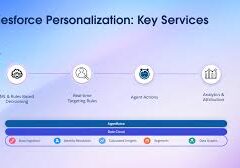Leveraging Email Marketing in Account-Based Marketing (ABM) Strategies
Email marketing is a versatile and powerful tool for targeted outreach, and its impact is amplified when integrated into an account-based marketing (ABM) strategy. ABM focuses on delivering highly personalized campaigns to specific high-value accounts rather than casting a wide net over general segments. Combining the precision of ABM with the direct reach of email marketing allows businesses to create impactful, tailored campaigns that drive engagement and conversion. Here’s a closer look at how email marketing can become a cornerstone of your ABM strategy, along with practical tips for success.
What is Email Marketing in an ABM Strategy?
In the context of ABM, email marketing moves beyond generic outreach to focus on creating tailored experiences for specific accounts. It enables businesses to deliver content and messaging directly to decision-makers within target organizations, addressing their unique pain points and needs.
To harness email marketing within ABM, marketers must:
- Build and refine targeted account lists: Identify and segment your key accounts based on strategic relevance and potential impact.
- Leverage personalization: Craft email content that reflects the priorities and challenges of individual accounts.
- Use data insights: Track performance metrics to iterate and enhance your campaigns.
Identifying and Segmenting Target Accounts
Effective email marketing for ABM begins with identifying the right accounts and dividing them into meaningful segments. Here’s how to approach it:
- Define the Ideal Customer Profile (ICP): Start by outlining the industries, company sizes, and roles that align with your objectives.
- Research and validate accounts: Use CRM data, social media insights, and third-party tools to confirm alignment with your ICP.
- Segment strategically: Group accounts by factors like industry, location, or buying stage to create hyper-relevant campaigns.
Crafting Highly Personalized Email Campaigns
Personalization is the backbone of email marketing in ABM. Tailored messaging ensures that your emails resonate with recipients. Key tactics include:
- Dynamic content: Use personalization tokens to address recipients by name, reference their company, or highlight relevant solutions.
- Account-specific insights: Incorporate data such as recent activities, industry challenges, or competitor trends to make your message impactful.
- Compelling CTAs: Guide recipients toward actions that align with their business needs, such as booking a consultation or downloading a custom resource.
Integrating Email Marketing with Multichannel ABM
Email marketing becomes even more effective when paired with other ABM channels. Consider these integration strategies:
- Coordinate messaging: Align email content with social media ads, direct mail, and events to reinforce your value proposition.
- Nurture through multiple touchpoints: Use emails to follow up on webinars or in-person meetings, ensuring continuity in the customer journey.
- Automate workflows: Trigger email sequences based on recipient behavior, such as website visits or content downloads.
Measuring Success: Key Metrics to Track
To refine your email campaigns and ensure alignment with your ABM goals, track these essential metrics:
- Open rate: Indicates the effectiveness of your subject line and sender reputation.
- Click-through rate (CTR): Reflects the relevance of your email content and call-to-action.
- Conversion rate: Measures how well your emails drive desired outcomes, such as form submissions or bookings.
- Engagement duration: Tracks how long recipients spend interacting with your content.
- Bounce rate: Highlights any issues with your email list’s accuracy or quality.
*See definitions below.
Best Practices for Ongoing Improvement
- Experiment with A/B testing: Test variations in subject lines, content, and design to optimize performance.
- Refresh account lists regularly: Ensure your target accounts remain aligned with your business goals.
- Focus on relevance: Prioritize quality over quantity by delivering timely, pertinent information.
- Leverage feedback loops: Use analytics to understand recipient behavior and iterate on your approach.
By aligning email marketing with your ABM strategy, you can deliver tailored, high-impact campaigns that resonate with decision-makers and drive meaningful results. When executed thoughtfully, email marketing becomes a powerful lever for strengthening relationships with high-value accounts and converting them into loyal customers.
Editor’s Note:
The formula for calculating click-through rate (CTR) is: CTR = clicks ÷ impressions and CTR = (number of clicks / number of impressions) x 100.
CTR is a ratio that shows how often people click on an ad or free product listing after seeing it. For example, if an ad has 5 clicks and 100 impressions, the CTR is 5%.
CTR is an important metric because it helps understand what works and what doesn’t when trying to reach a target audience. A low CTR could mean that the wrong audience is being targeted or that the message isn’t persuasive enough.
Factors that can affect CTR include: The campaign being run, The keywords being targeted, The channel and purpose of the ad, The industry, and The ad’s position.
As of 2023-2024, the average CTR for display advertising campaigns is around 0.5-1%.
The formula to calculate an email open rate is:
- Open rate = (Number of emails opened / Number of delivered emails) x 100
To calculate the open rate, you need two variables:
- Total recipients: The number of email addresses on your mailing list
- Total unique opens: The number of recipients who opened your email
The open rate is a percentage that measures the success of your email marketing campaign. It’s a critical metric that reflects how engaged your audience is with your campaigns.
You can use an email open rate calculator to help you determine the effectiveness of your email marketing campaigns.
Factors that can influence your email open rate include:
- The relevance and personalization of your content
- The quality of your email subject lines
- The consistency of your sending schedule
- The segmentation of your email lists
- The optimal timing of your emails based on your audience’s behavior
The average email open rate across all industries is 17.92%. However, open rates vary from industry to industry and depend on the quality of your email list.
By Tectonic Solutions Architect, Shannan Hearne













